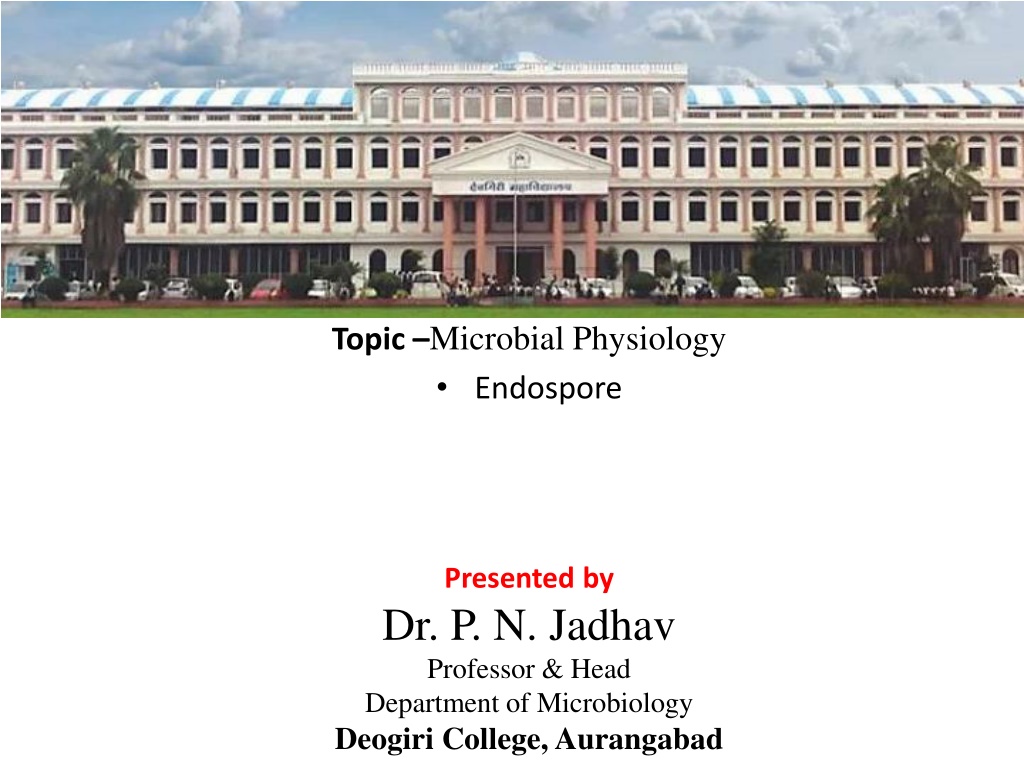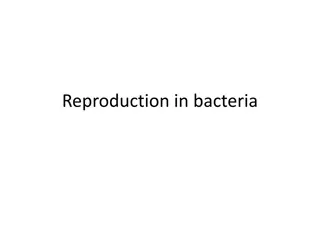
Understanding Microbial Physiology: The Fascinating World of Endospores
Explore the concept of microbial endospores presented by Dr. P. N. Jadhav, a professor at Deogiri College, Aurangabad. Learn about endospore formation, structure, and germination, along with the processes of sporulation and spore coat protection. Dive into the mechanisms of nutrient uptake in bacteria and archaea through passive diffusion, facilitated diffusion, and active transport.
Download Presentation

Please find below an Image/Link to download the presentation.
The content on the website is provided AS IS for your information and personal use only. It may not be sold, licensed, or shared on other websites without obtaining consent from the author. Download presentation by click this link. If you encounter any issues during the download, it is possible that the publisher has removed the file from their server.
E N D
Presentation Transcript
Topic Microbial Physiology Endospore Presented by Dr. P. N. Jadhav Professor & Head Department of Microbiology Deogiri College, Aurangabad
B. Sc. First Year Semester II Paper IV- Cytology and General Microbiology Unit 3: Microbial Physiology -Endospore
Endospore s: Resting stage during lean or stressful times . Resistant protein coat! free; sub-terminal; central; terminal Develop in different locations of vegetative cell: Young (24 h) Schaeffer Fulton Stain: Old (96 h)
Endospores & Sporulation (corte x) Dipicolinic Acid & Calcium protects DNA from heat. Spore coat proteins resist toxic chemicals. exospori um
Spore Germination: activation; germination; outgrowth
Uptake of nutrients: In order to support its activities, a cell must bring in nutrients from the external environment across the cell membrane. In bacteria and archaea, several different transport mechanisms exist. Passive Diffusion Passive or simple diffusion allows for the passage across the cell membrane of simple molecules and gases, such as CO2, O2, and H2O. In this case, a concentration gradient must exist, where there is higher concentration of the substance outside of the cell than there is inside the cell. As more of the substance is transported into the cell the concentration gradient decreases, slowing the rate of diffusion. Facilitated Diffusion Facilitated diffusion also involves the use of a concentration gradient, where the concentration of the substance is higher outside the cell, but differs with the use of carrier proteins (sometimes called permeases). These proteins are embedded within the cell membrane and provide a channel or pore across the membrane barrier, allowing for the passage of larger molecules. If the concentration gradient dissipates, the passage of molecules into the cell stops. Each carrier protein typically exhibits specificity, only transporting in a particular type of molecule or closely related molecules.
Active transport Many types of nutrient uptake require that a cell be able to transport substances against a concentration gradient (i.e. with a higher concentration inside the cell than outside). In order to do this, a cell must utilize metabolic energy for the transport of the substance through carrier proteins embedded in the membrane. This is known as active transport. All types of active transport utilize carrier proteins.
Primary active transport Primary active transport involves the use of chemical energy, such as ATP, to drive the transport. One example is the ABC system, which utilizes ATP- Binding Cassette transporters. Each ABC transporter is composed of three different components: 1) membrane-spanning proteins that form a pore across the cell membrane (i.e. carrier protein), 2) an ATP binding region that hydrolyzes ATP, providing the energy for the passage across the membrane, and 3) a substrate-binding protein, a peripheral protein that binds to the appropriate substance to be transporter and ferries it to the membrane-spanning proteins. In gram negative bacteria the substrate- binding protein is located in the cell s periplasm, while in gram positive bacteria the substrate-binding protein is attached to the outside of the cell membrane.
Secondary active transport Secondary active transport utilizes energy from a proton motive force (PMF). A PMF is an ion gradient that develops when the cell transports electrons during energy- conserving processes. There are three different types of transport events for simple transport: uniport, symport, and antiport and each mechanism utilizes a different protein porter. Uniporters transp ort a single substance across the membrane, either in or out. Symporters transport two substances across the membrane at the same time, typically a proton paired with another molecule. Antiporters transport two substances across the membrane as well, but in opposite directions. As one substance enters the cell, the other substance is transported out.
Group Translocation Group translocation is a distinct type of active transport, using energy from an energy-rich organic compound that is not ATP. Group translocation also differs from both simple transport and ABC transporters in that the substance being transported is chemically modified in the process.
Uptake of metals Iron is required by microbes for the function of their cytochromes and enzymes, resulting in it being a growth- limiting micronutrient. However, little free iron is available in environments, due to its insolubility. Many bacteria have evolved siderophores, organic molecules that chelate or bind ferric iron with high affinity. Siderophores are released by the organism to the surrounding environment, whereby they bind any available ferric iron. The iron-siderophore complex is then bound by a specific receptor on the outside of the cell, allowing the iron to be transported into the cell.
Photosynthetic organisms Anoxygenic Photosynthesis Green and purple (sulfur and non- sulfur) bacteria and heliobacteria Oxygenic Photosynthesis Cyanobacteria
Pigments Bacteriochlorophyll a Light harvesting pigments Bacteriochlorophyll (bchl) for anoxygenic photosynthesis Chlorophyll for oxygenic photosynthesis Different varieties that can absorb light at different wavelengths Harness energy from light to excite electrons to higher energy states (more reducing, more negative E0) these high energy electrons go through the electron transport chains to ultimately produce energetic molecules like ATP and NADPH to drive biochemical reactions in the cell 180px-Chlorophyll_a
Anoxygenic photosynthetic organisms Purple and green bacteria utilize bchl and H2S, S8, S2O32-, H2, Fe2+, and organics as electron donor Many can deposit elemental sulfur intracellularly (and sometime outside the cell (epicellularly) to store that when H2S is unavailable The term non-sulfur does not necessarily mean they can t use sulfur - they are generally adapted to environments with less sulfur Heliobacteria Nitrogen- fixing, heterotrophic organisms found in soils and rice paddies Beggiatoa spp.
Oxygenic Photosynthesis Chlorphyll a (P680) is very oxidized (E0=+1.1V), enough to oxidize H2O. BUT e- excitation takes it to E0=-0.7V, not enough to reduce NADP+ to NADPH. Thus a need for 2 photosystems . Water-oxidizing complex is key Mn4Ca-complex that oxidizes H2O to O2 in 4 steps (S0 through S4)
Non-cyclic phosphorylation Coupled photosystems linked by plastocyanin (pc), which takes the e- excited by P680, after it goes through the Q pool, and puts it into a similar chlorophyll a (P700) which is excited by a photon to a very reduced potential (- 1.3V) that can reduce NADP+ to NADPH If there is enough NADPH, PS I can act independently and function for cyclic phosphorylation
THERE ARE TWO PHASES IN PHOTOSYNTHESIS THE LIGHT REACTION H2O IS SPLIT 2 H2O NADPH AND ATP ARE GENERATED THE DARK REACTION NADPH AND ATP FROM THE LIGHT REACTION DRIVES CH2O PRODUCTION FROM CO2 AND [H ] : O2 + 4 [H ] 4 [H ] + CO2 (CH2O) + H2O IT S REALLY A LIGHT-INDEPENDENT REACTION YOU HAVE ALREADY STUDIED IT THE CALVIN CYCLE
PHOTOSYNTHESIS OCCURS IN CHLOROPLASTS CHLOROPLASTS CONTAIN: AN OUTER MEMBRANE HIGH PERMEABILITY AN INNER MEMBRANE NEARLY IMPERMEABLE THE STROMA AQUEOUS CONTAINS ENZYMES, DNA, RNA, RIBOSOMES THE THYLAKOID A MEMBRANEOUS COMPARTMENT DERIVED FROM INVAGINATIONS OF INNER MEMBRANE A SINGLE HIGHLY-FOLDED VESICLE GRANA : DISK-LIKE SACS GRANA ARE CONNECTED BY STROMAL LAMELLAE
CHLOROPLASTS STRUCTURE IS VERY SIMILAR TO MITOCHONDRIA PROBABLY EVOLVED FROM A CYANOBACTERIUM INCORPORATED INTO A NON-PHOTOSYNTHETIC EUKARYOTE (SYMBIOSIS) IN EUKARYOTES, THE LIGHT REACTION OCCURS IN THYLAKOID MEMBRANE IN PROKARYOTES, THE LIGHT REACTION OCCURS IN: INNER (PLASMA) MEMBRANE IN CHROMATOPHORES INVAGINATIONS OF INNER MEMBRANE IN EUKARYOTES, THE DARK REACTION OCCURS IN THE STROMA
CHLOROPHYLL IS THE MAJOR PHOTORECEPTOR IN PHOTOSYNTHESIS A CYCLIC TETRAPYRROLE, LIKE HEME, BUT: HAS A CENTRAL Mg2+ ION A CYCLOPENTANONE RING (RING V) IS FUSED TO PYRROLE RING III PARTIAL REDUCTION OF RING IV IN EUKARYOTES AND CYANOBACTERIA CHLOROPHYLL a CHLOROPHYLL b OR IN RINGS II AND IV IN PHOTOSYNTHETIC BACTERIA BACTERIOCHLOROPHYLL a BACTERIOCHLOROPHYLL b
MOLECULAR EVENTS DURING LIGHT ABSORPTION PHOTONS (LIGHT PARTICLES ) ENERGY = h PHOTORECEPTORS HIGHLY CONJUGATED MOLECULES STRONGLY ABSORB VISIBLE LIGHT ABSORPTION OF A PHOTON USUALLY PROMOTES A GROUND- STATE ELECTRON TO A MOLECULAR ORBITAL OF HIGHER ENERGY LAW OF CONSERVATION OF ENERGY EACH ELECTRONIC ENERGY LEVEL HAS VIBRATIONAL AND ROTATIONAL SUB-STATES
POSSIBLE FATES OF EXCITED ELECTRON INTERNAL CONVERSION (A FAST PROCESS) ELECTRONIC ENERGY CONVERTED TO KINETIC (HEAT) ENERGY SOMETIMES RELAX BACK TO GROUND STATE IN CHLOROPHYLL, RELAXATION TO LOWEST EXCITED STATE FLUORESCENCE (A SLOWER PROCESS) A PHOTON IS EMITTED, WITH DECAY TO GROUND ELECTRONIC STATE EXCITON TRANSFER ( RESONANCE TRANSFER ) EXCITATION ENERGY TRANSFERRED TO NEARBY UNEXCITED MOLECULES WITH SIMILAR ELECTRONIC PROPERTIES PHOTO-OXIDATION THE EXCITED MOLECULE TRANSFERS ITS ELECTRON TO AN ACCEPTOR MOLECULE A REDOX PAIR
EXCITON TRANSFER COUPLING OF MOLECULAR ORBITALS ALLOWS FOR SERIAL TRANSFER OF EXCITATION OR COUPLED MOLECULES ACT AS A SUPERMOLECULE THIS KIND OF TRANSFER IS SEEN AS LIGHT ENERGY IS FUNNELED TO PHOTOSYNTHETIC REACTION CENTERS

